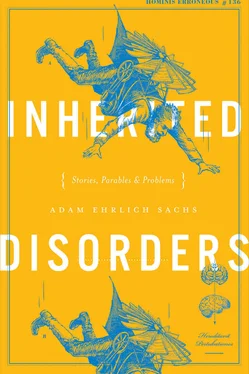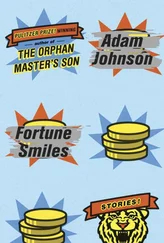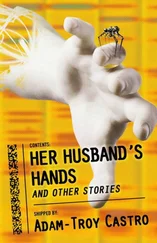My friend — it occurs to me now that that’s the wrong designation — brought over his father’s head in the big freezer, and I never saw or heard from him again. But the labor historian’s head and I embarked on a pretty wonderful little life together. We saw a lot of the world. He improved my life in a number of ways, personally and professionally. And a few years later, while the son was still flailing around L.A., I broke my promise and had his father resurrected. They affixed his head to an animatronic body and zapped the whole thing with an ultraprecise amount of electricity. So, he’s back now. He’s back at Princeton, too, where he teaches a popular lecture course called Work in America . Just one semester a year, a sort of semiretirement. He’s a great guy. Our relationship is a little more complicated — obviously — than when he was a just a frozen head, but it’s still very, very solid. We talk about everything. The only thing we never talk about is his son.
…………………….
A particular line of male lab rats has exhibited, from generation to generation, a marked improvement in maze performance, suggesting that the skill may in fact be heritable. The first rat in this line completed the maze in one minute and fifty-nine seconds. His sons finished the maze in an average time of one minute and forty-two seconds. The third generation ran it in an average time of one minute and twenty-five seconds, and the fourth generation finished it on average in one minute and seven seconds. Unfortunately, the trend ended with the fifth generation. After an hour in the maze, the fifth generation of rats had still not budged from the starting line. It is not known whether they were unable to move or unwilling . They were also unable or unwilling to mate, so the experiment has since been discontinued. Upon dissection, their brains were found to be pathologically large.
…………………….
By twenty-nine, he had funneled some of his father’s billions into the movie industry. Yet instead of being called a “human money funnel” or a “prominent human tube,” or even a “major fiscal shunt,” he’s described in a recent issue of Forbes magazine as “one of the most successful young producers in Hollywood.”
…………………….
The humiliating end of Elliot Evans, for many years England’s most famous medium, was witnessed by nearly the entire nation.
Evans, who came from a line of psychologists, had made his name in the 1940s and ’50s by “channeling” the voices of British soldiers killed during the Second World War. In 1959, the BBC announced that Evans would channel, live on television, Prince George, the only member of the British royal family to die during the war. It is reported that forty million people tuned in to watch the séance. Evans, dashing in his tuxedo, sat onstage with George’s son, Prince Edward. Evans took Edward’s hand and fell into one of his famous trances. Then — disaster. As all of England watched, Evans began shouting into the Prince’s face: WHAT IS A MEDIUM? WHAT DOES A MEDIUM DO ? DO YOU KNOW ANY OTHER MEDIUMS? YOU’VE NEVER MENTIONED BECOMING A MEDIUM BEFORE .
After a full minute of this, Evans woke from his trance and clambered offstage. The next day he apologized to the nation, explaining that he had accidentally channeled his own father instead of Prince Edward’s.
Alas, his ability to channel men other than his father steadily declined, and by the early 1970s he could channel only his father, who kept wondering — through the medium of Evans — what a medium was , what a medium did , whether he knew any other mediums, and why he had never mentioned becoming a medium before . Evans continued to make a living, but only as a kind of novelty act, and in fall 1981 he disappeared during a long walk in the Scottish Highlands.
…………………….
The son of the serial killer who terrorized the greater Tucson area for fifteen years, from 1989 to 2004, granted a single interview after his father’s arrest, in which he answered, rather eloquently, the question the country was asking: How was it possible to live under a man’s roof for so long and not realize that he’s a serial killer?
“I think,” he replied, “the people closest to us are sometimes the most opaque to us. Perhaps the closer we are, the more ignorant we are.”
Early in the trial it emerged that the son had once discovered four human femurs in his father’s sock drawer. He granted another interview. “Even the people we love are, in the end, utterly inscrutable to us,” he said. “We believe we have unhindered access to their minds, but we actually have no access whatsoever.”
Later it came out that the son had once found two human heads simmering in two large cauldrons on the stove. “Even the consciousness that seems nearest to us is still infinitely far away,” he explained in an interview.
The family ate human hearts and owned a quilt stitched from skin, at home the father wore a necklace made of toes, and on another occasion the son discovered three human heads simmering in three cauldrons on the stove. “Another person’s mind is always a mystery to us,” the son said in his most recent interview.
76: THE MADMAN’S TIME MACHINE
…………………….
On the coldest night of the year a madman was taken to Boston Medical Center with third-degree frostbite. Police had found him under an overpass naked in a cardboard box. Scrawled on the box in black magic marker were the words: TIME MACHINE.
Oddly, the frostbitten madman was jubilant.
Until recently, he told the psychiatrist assigned to him, he had been the most intelligent person in history, smarter even than Einstein (“if only by a little bit”) and Newton (“if only by a little bit”). But his historic intelligence had been a curse.
“Being able to perceive the true nature of everything instantly is actually awful,” he told the psychiatrist. He had grown bored and lonely. The moment he embarked on a thought, he reached its logical terminus. “At some point,” he said, “there is just nothing left to think. Meanwhile everyone else is back there at the first principles, the assumptions, the postulates.”
He investigated the great problems of cosmology but solved them immediately. In May he ended metaphysics. He turned to the nature of time, which he hoped would divert his mind for at least a few weeks, but the nature of time revealed itself to him in an afternoon. Once again he was bored and lonely. So he built the time machine.
“That right there?” asked the psychiatrist, gesturing at the cardboard box, which the madman had refused to relinquish.
“ That ,” said the madman with a strange smile, “is merely a cardboard box.”
The real time machine, he said, was obviously much more complicated, and was obviously made entirely or almost entirely out of metal. For a while it had relieved his boredom. He visited the recent past, then the near future, then the distant past, and then the remote future. He sought out the company of his fellow geniuses. He discussed gravity with Galileo and buoyancy with Archimedes. He brought Fermat to the near future and ate future bagels, which are “much puffier and much more moist,” according to the madman, than the bagels of today. He met one of the most important thinkers of the remote future, a mammoth reptilian creature with an unpronounceable name, and took him back in time to meet Louis XIV, the so-called Sun King. This meeting, said the madman, was “incredibly awkward.”
Читать дальше












